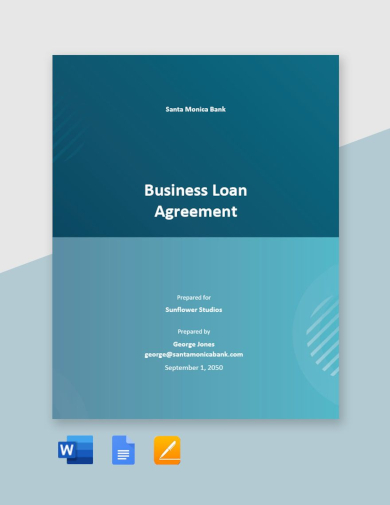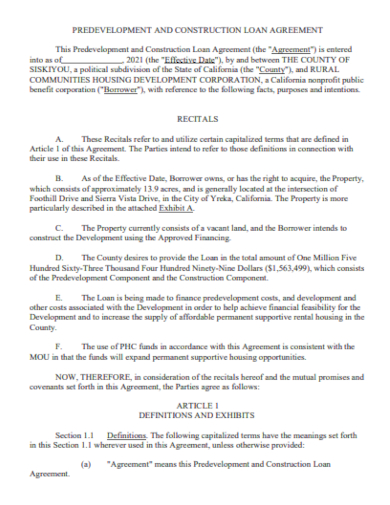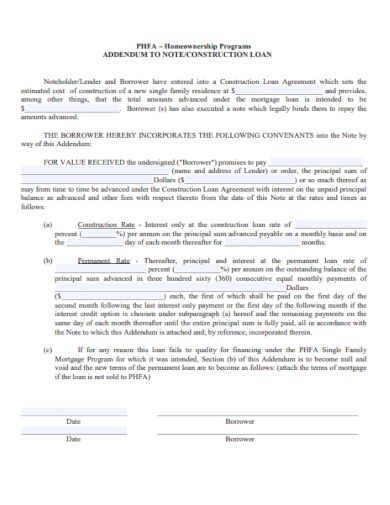25+ SAMPLE Construction Loan Agreement
-

Construction Agreement Template
download now -

Restaurant Loan Agreement Template
download now -

Draft Loan Agreement Template
download now -

Simple Construction Agreement Template
download now -

Basic Business Loan Agreement Template
download now -

Construction Loan Agreement
download now -

Sample Construction Loan Agreement
download now -

Construction Development Loan Agreement
download now -

Printable Construction Loan Agreement
download now -

Housing Construction Loan Agreement
download now -

Construction Predevelopment Loan Agreement
download now -

Syndicated Construction Loan Agreement
download now -

Bank Construction Loan Agreement
download now -

Construction Mortgage Loan Agreement
download now -

Home Construction Loan Agreement
download now -

Construction Funding Agreement
download now -

Construction Loan Support Agreement
download now -

Construction Loan Partnership Agreement
download now -

Construction Services Loan Agreement
download now -

Construction Loan Disbursement Agreement
download now -

Construction Loan Credit Agreement
download now -

Construction Funding Loan Agreement
download now -

Addendum to Construction Loan Agreement
download now -

Construction Loan Agreement Format
download now -

Construction Borrower Loan Agreement
download now -

Housing Loan Agreement
download now
FREE Construction Loan Agreement s to Download
25+ SAMPLE Construction Loan Agreement
Definition:
Diving into the World of Construction Loan Agreements:
Key Elements of a Construction Loan Agreement:
The Borrower-Lender Relationship:
Potential Hurdles and How to Overcome Them:
Technological Advances in Managing Agreements:
Strategies for a Smooth Loan Journey:
How does the agreement address the disbursement of funds and project budgeting?
What measures are taken to assess project risk and establish mitigation strategies in the agreement?
Why should the agreement outline the responsibilities and roles of all parties involved?
Can the agreement serve as a foundation for the eventual construction contract?
Definition:
A Construction Loan Agreement is a binding contract between a borrower and a lender, specifying the terms under which construction financing is provided. This agreement outlines the loan amount, interest rate, disbursement schedule, repayment terms, and other conditions. It ensures that funds are utilized for construction purposes and provides a framework for monitoring the project’s financial progress and milestones.
Diving into the World of Construction Loan Agreements:
The foundation of any successful construction project often rests on secure financing. A Construction Loan Agreement offers a structured framework for this, ensuring that both the borrower and lender are on the same page, financially speaking.
Key Elements of a Construction Loan Agreement:
A well-drafted agreement should comprehensively address several primary components:
- Loan Amount and Disbursement: Detailing the total sum to be borrowed and the schedule or criteria upon which funds will be released.
- Interest Rate and Calculation Method: Defining the percentage of interest on the principal amount and how it will be computed, whether it’s fixed or variable.
- Repayment Structure: Outlining the frequency of payments, the amount per installment, and the duration over which the loan will be repaid.
- Collateral and Security: Specifying assets, often the construction project itself, that serve as security for the loan, ensuring the lender can recoup funds if the borrower defaults.
- Covenants and Conditions: Stipulations or performance criteria the borrower must adhere to, which might include project progress benchmarks or financial ratios.
- Default Provisions: Clarity on what constitutes a default, the repercussions for the borrower, and the rights of the lender in such scenarios.
- Rights and Responsibilities: Clear delineation of both parties’ obligations, from providing timely information to ensuring the project adheres to codes and regulations.
- Early Payment or Prepayment: Conditions under which the borrower can pay off the loan before its maturity, including any penalties or benefits.
- Termination or Conclusion: Provisions detailing the circumstances under which the agreement can be terminated, and the procedures to close out the loan once the project is complete.
The Borrower-Lender Relationship:
A Construction Loan Agreement doesn’t just outline terms; it shapes the relationship between the involved parties. Open communication, transparency, and mutual understanding are paramount, ensuring both parties can navigate challenges and seize opportunities.
Building Trust and Transparency:
Emphasizing the importance of honest communication and clarity in all dealings to foster a strong bond between the parties.
Due Diligence and Vetting:
Highlighting the initial research and checks both parties undertake to ascertain the credibility and capability of the other.
Financial Flexibility:
Exploring potential accommodations, like grace periods or modified repayment terms, which can be considered in unforeseen circumstances.
Collaborative Problem Solving:
The mutual benefit of approaching challenges as a team, working together to find solutions that protect both the project’s success and the loan’s security.
Compliance and Reporting:
Discussing the borrower’s responsibility to adhere to agreed-upon terms and the importance of timely, accurate reports that keep the lender informed.
Respect for Contractual Obligations:
Reinforcing the importance of honoring all aspects of the agreement, ensuring both parties’ interests are safeguarded.
Mutual Growth and Development:
Recognizing that a successful project, financed effectively, can lead to future collaborations and growth opportunities for both parties.
Feedback and Continuous Improvement:
Encouraging an open feedback loop where both parties can suggest improvements, enhancing the efficiency and effectiveness of future loan agreements.
Potential Hurdles and How to Overcome Them:
While construction loans offer invaluable financial support, they come with challenges:
Fluctuating Market Conditions:
Highlighting the unpredictable nature of the construction market and strategies to mitigate potential financial impacts.
Documentation Discrepancies:
Addressing the challenges of ensuring all paperwork is accurate, up-to-date, and reflecting the real-time status of the project.
Delays in Project Timelines:
Discussing common causes of delays, from supply chain interruptions to permitting issues, and how to navigate them efficiently.
Interest Rate Volatility:
Exploring ways to lock in favorable rates or adopt flexible financing structures to manage unforeseen interest rate shifts.
Scope Creep and Budget Overruns:
Stressing the importance of a clear project scope and mechanisms to handle unexpected costs or expanded project parameters.
Miscommunication or Misunderstandings:
Emphasizing the need for open channels of communication, regular check-ins, and clear documentation to prevent information gaps.
Unforeseen Site Challenges:
Detailing strategies to address unexpected site issues, from soil problems to archaeological discoveries, without derailing the project.
Regulatory and Compliance Hurdles:
Navigating the complex world of construction regulations, permits, and inspections, ensuring all work meets legal and safety standards.
Lender-Borrower Conflicts:
Highlighting the importance of a clear conflict resolution strategy within the loan agreement to manage disputes proactively.
Changes in Project Specifications:
Addressing how to manage changes in project specs, whether due to client requests or unforeseen challenges, without compromising the budget or timeline.
Technological Advances in Managing Agreements:
Modern construction projects aren’t just about bricks and mortar; they’re intertwined with technology. Digital tools, such as loan management software and cloud-based collaboration platforms, can streamline the process, ensuring real-time updates, easier documentation, and swifter dispute resolution.
Digital Document Management:
Exploring the ease and efficiency brought by cloud-based platforms that allow for real-time tracking, editing, and sharing of agreement documents.
e-Signatures and Online Verification:
Delving into the convenience and security of electronically signing agreements, reducing the need for physical paperwork and in-person meetings.
Automated Payment Systems:
Highlighting the benefit of using technology for automated disbursals, ensuring timely payments and reducing manual tracking errors.
Blockchain in Contract Management:
Understanding how blockchain technology can provide a tamper-proof, transparent ledger for all contractual transactions.
Artificial Intelligence in Risk Assessment:
Discussing the role of AI in analyzing agreement terms and predicting potential risks, offering insights to make informed decisions.
Mobile Access and Notifications:
Emphasizing the advantages of mobile platforms that allow stakeholders to access agreements, updates, and communicate on-the-go.
Virtual Reality and Augmented Reality:
Exploring the possibilities of using VR and AR for virtual site visits or visualizing project outcomes before signing an agreement.
Integrated Communication Platforms:
The importance of unified platforms that integrate contract management with communication tools for seamless collaboration.
Data Analytics for Performance Tracking:
Delving into how advanced analytics can monitor the progress against agreement terms, ensuring projects stay on track.
Cyber Security Measures:
Stressing the importance of protecting digital agreements with advanced security protocols to prevent unauthorized access or breaches.
Strategies for a Smooth Loan Journey:
With a clear understanding of the agreement’s complexities, here are some strategies to ensure smooth sailing:
Understanding the Loan Structure:
Gaining clarity on how the loan is structured, including interest rates, disbursement schedules, and repayment terms.
Pre-Approval Consultations:
Engaging in discussions with the lender before applying to gauge eligibility, ensuring a higher chance of loan approval.
Detailed Documentation:
Ensuring that all necessary documents, from project plans to financial records, are well-prepared and organized.
Open Communication with Lenders:
Maintaining regular updates and open channels of communication with lenders to address concerns and provide clarifications promptly.
Conducting Regular Audits:
Regularly checking and verifying the funds’ utilization against the project’s progress ensures alignment with the loan’s purpose.
Ensuring Timely Repayment:
Staying on top of repayment schedules to avoid penalties, maintain good credit standing, and build a strong relationship with the lender.
Engaging in Mediation for Disputes:
Opting for mediation or arbitration in case of disagreements, ensuring a smoother resolution process without legal entanglements.
How does the agreement address the disbursement of funds and project budgeting?
The construction loan agreement clearly stipulates disbursement milestones tied to project phases, ensuring funds are released as work progresses. Detailed budgeting is outlined, specifying allocation for materials, labor, and other expenses. Regular audits may be mandated to confirm funds are used appropriately, providing transparency and mitigating financial discrepancies.
What measures are taken to assess project risk and establish mitigation strategies in the agreement?
The agreement incorporates thorough risk assessments, analyzing potential project setbacks like delays, budget overruns, or regulatory challenges. Based on these assessments, mitigation strategies are set, including contingency funds, insurance requirements, and adaptive project timelines. These measures ensure both parties are protected and potential issues are proactively addressed.
Why should the agreement outline the responsibilities and roles of all parties involved?
Outlining roles and responsibilities in the agreement ensures clarity, minimizes ambiguities, and reduces potential disputes. By clearly defining each party’s obligations, it sets performance benchmarks, streamlines project execution, and fosters accountability. This clarity is essential for smooth collaboration, ensuring that project milestones are met and stakeholders’ expectations are aligned.
Can the agreement serve as a foundation for the eventual construction contract?
Yes, the agreement can serve as a foundation for the eventual construction contract. It establishes preliminary terms, budgetary constraints, and project outlines, which can be expanded upon and detailed in the final contract. Using the agreement as a basis ensures consistency, clarity, and a seamless transition from financing to construction phases.
In wrapping up our exploration of Construction Loan Agreement, it’s evident that meticulous planning and understanding are crucial. By acquainting yourself with key facets like loan disbursement, interest rates, and repayment structures, you safeguard your construction venture’s financial aspects. For a deeper grasp on industry financial practices and ensuring a solid financial footing, continue diving into our expansive resources.
